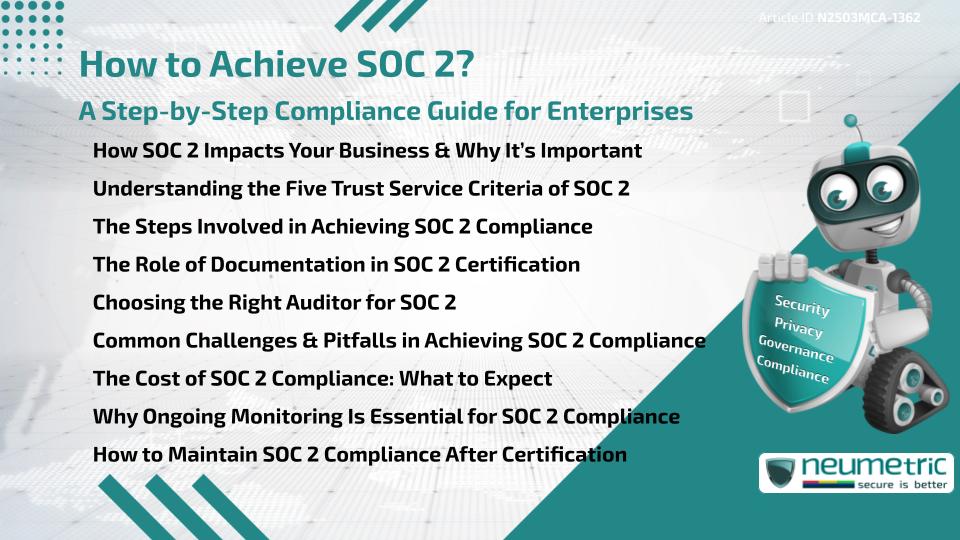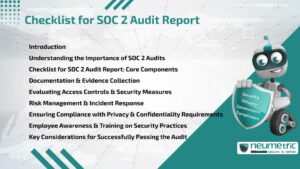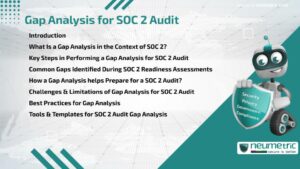Table of Contents
ToggleIntroduction
Achieving SOC 2 Compliance is a crucial milestone for any organization handling Sensitive Data, particularly in the tech and SaaS industries. The System and Organization Controls (SOC) 2 framework was developed by the American Institute of Certified Public Accountants (AICPA) to ensure that service providers maintain high standards of data security, privacy, and confidentiality. This article will explore how to achieve SOC 2 Compliance, offering a step-by-step guide to navigating the process successfully. From understanding the fundamentals to preparing for the audit, we’ll cover everything you need to know to ensure your enterprise meets the requirements.
What is SOC 2?
SOC 2 is a set of criteria that focuses on the control systems of an organization. It evaluates the organization’s policies and procedures related to five key trust service criteria: security, availability, processing integrity, confidentiality, and privacy. These criteria aim to protect data and ensure that systems are operated efficiently, securely, and transparently. By meeting these requirements, enterprises can demonstrate to their clients and partners that they are taking the necessary steps to safeguard sensitive information.
A Step-by-Step Compliance Guide for Enterprises:
Step 1: Understand the SOC 2 Trust Service Criteria
Before embarking on the SOC 2 Compliance journey, it’s important to familiarize yourself with the five trust service criteria, which will guide your security practices:
- Security: Ensures that the system is protected against unauthorized access.
- Availability: Guarantees that the system is available for operation and use as agreed upon.
- Processing Integrity: Ensures that system processing is complete, accurate, and timely.
- Confidentiality: Protects confidential information from unauthorized access.
- Privacy: Ensures that personal information is collected, used, retained, and disclosed in a way that respects privacy rights.
Understanding these criteria will serve as the foundation for the changes you need to make within your organization to meet SOC 2 requirements.
Step 2: Choose the Type of SOC 2 Report
There are two types of SOC 2 reports: Type I and Type II.
- Type I evaluates the design and implementation of your controls at a specific point in time.
- Type II assesses the operational effectiveness of those controls over a period of at least six months.
While Type I may seem easier, Type II is generally preferred by clients as it demonstrates the sustained effectiveness of your security practices over time. In most cases, enterprises aim for a Type II report.
Step 3: Perform a Readiness Assessment
A readiness assessment is an internal evaluation that identifies gaps in your organization’s controls. It helps you understand how well your current security practices align with SOC 2 requirements. During this stage, review your existing policies, procedures, and Security Frameworks to pinpoint areas for improvement.
This step may involve:
- Conducting risk assessments.
- Reviewing existing security protocols.
- Identifying the resources (both human and technological) required to fill any gaps.
The readiness assessment lays the groundwork for the changes and improvements needed to meet SOC 2 standards.
Step 4: Implement the Necessary Controls
Once you have identified areas for improvement, the next step is to implement the necessary controls and policies to close those gaps. Controls will need to be put in place for the five trust service criteria. This may include:
- Security Controls: Setting up firewalls, encryption protocols, and access controls to prevent unauthorized access to systems and data.
- Monitoring and Auditing: Regular monitoring of systems to identify vulnerabilities and ensure that policies are followed.
- Employee Training: Providing ongoing training for employees on data security best practices and your organization’s specific policies.
- Data Backups: Implementing regular data backup procedures to ensure business continuity.
Implementing the right controls is essential for ensuring your systems are compliant with SOC 2 requirements.
Step 5: Prepare for the Audit
Once your controls are in place, it’s time to prepare for the actual SOC 2 audit. This involves gathering the necessary documentation, evidence, and records to demonstrate your adherence to SOC 2 criteria. You’ll need to prepare reports on:
- The security measures you have taken to protect data.
- The policies in place to ensure data privacy and confidentiality.
- Any monitoring and reporting systems used to track and review your processes.
Be prepared to answer any questions auditors might have and provide additional documentation as needed.
Step 6: Undergo the Audit
The audit process is conducted by an independent auditor who will evaluate your compliance with SOC 2. For a Type I report, the auditor will assess whether your controls are properly designed. For Type II, the auditor will also test how effectively the controls were maintained over time.
This audit is a thorough process, and it’s crucial to have all your documentation and evidence in order to ensure a smooth audit. Auditors will assess everything from physical security measures to your company’s policies on data privacy.
Step 7: Address Findings and Receive the Report
After the audit, the auditor will provide a report detailing any findings. If there are deficiencies or areas of improvement, you will need to address these before the report can be finalized. Once all findings are addressed, you will receive your SOC 2 certification.
SOC 2 reports are typically shared with clients and partners to demonstrate your compliance with industry standards and provide assurance about your data handling practices.
Conclusion
Achieving SOC 2 Compliance is a step-by-step process that requires commitment, diligence, and attention to detail. By understanding the SOC 2 trust service criteria, performing a readiness assessment, implementing the right controls, and preparing for the audit, enterprises can ensure that they meet the high standards required for data security and privacy. SOC 2 Compliance not only protects your organization but also builds trust with clients and stakeholders, helping to differentiate your business in a competitive marketplace.
Takeaways
- SOC 2 Compliance is a framework that focuses on data security, availability, processing integrity, confidentiality, and privacy.
- The process involves selecting the right SOC 2 report type, performing a readiness assessment, implementing necessary controls, and undergoing an audit.
- Preparing for the audit and addressing any findings is key to receiving your SOC 2 certification.
FAQ
What is SOC 2 Compliance?
SOC 2 Compliance ensures that an organization meets industry standards for data security, availability, processing integrity, confidentiality, and privacy.
How long does it take to achieve SOC 2?
The timeline varies but generally takes between six (6) to twelve (12) months, depending on the complexity of your organization’s systems and processes.
What is the difference between SOC 2 Type I and Type II?
SOC 2 Type I evaluates your controls at a specific point in time, while Type II assesses the effectiveness of those controls over a period of at least six (6) months.
How much does a SOC 2 audit cost?
The cost can vary widely based on factors like organization size, complexity, and the scope of the audit. On average, it can range from $10,000 to $50,000 or more.





